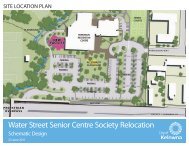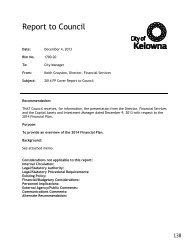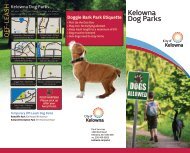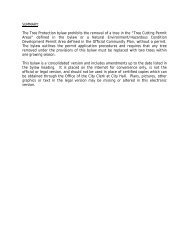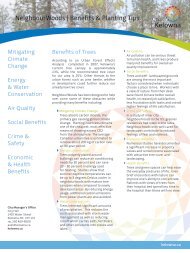Comprehensive Site Development Plan ... - City of Kelowna
Comprehensive Site Development Plan ... - City of Kelowna
Comprehensive Site Development Plan ... - City of Kelowna
You also want an ePaper? Increase the reach of your titles
YUMPU automatically turns print PDFs into web optimized ePapers that Google loves.
Avocets at Glenmore Landfill<br />
7<br />
Shoreline: Shoreline slopes should be 10:1 to 12:1 slope maximizing the shoreline area<br />
which can be used for foraging (Robinson et al. 1997).<br />
Nesting Islands: Compensation habitat should have numerous small islands or several<br />
large islands for nesting as outlined in Weir and Gyug (1999). Artificial nesting islands can be<br />
constructed in existing alkaline wetlands provided that foraging habitat exists already at those<br />
sites. In creating artificial nesting islands for American Avocets, a number <strong>of</strong> factors need to be<br />
considered (Robinson et al. 1997; Weir and Gyug 1999). These include: 1) distance and depths<br />
<strong>of</strong> water between island and shore, 2) size and distribution, 3) slope, 4) vegetative cover, 5)<br />
substrate, 6) height above water; and 7) durability.<br />
General recommendations for nesting islands (after Weir and Gyug 1999) include:<br />
• Minimum distance <strong>of</strong> 30 m to shore, and depth <strong>of</strong> water at least 1 m deep to protect against<br />
mammalian predators somewhere between shore and island.<br />
• Islands can be <strong>of</strong> almost any size, but if small islands are used they should be clustered.<br />
• Side slopes at 10:1 to 12:1 under water and above water (Figure 1). At Tulare Lake Drainage<br />
District in California, artificially created nesting islands with side slopes <strong>of</strong> 12:1 attracted<br />
large numbers <strong>of</strong> avocets but islands with side slopes <strong>of</strong> 3:1 were used to discourage avocet<br />
nesting (Tulare Lake Drainage District 1999). Burgess and Hirons (1992) constructed nesting<br />
islands for Pied Avocets (Recurvirostra avosetta) in Great Britain with side slopes <strong>of</strong> 10:1.<br />
• Vegetative coverage, if any, should be sparse and short on nesting islands. If vegetation is<br />
not to be controlled by water levels, then vegetation can be discouraged by placing several<br />
layers <strong>of</strong> weed resistant plastic over islands and then placing highly alkaline and saline clay<br />
on top <strong>of</strong> plastic. Salt can be spread over island surface to discourage plant growth.<br />
• Any natural material substrate is acceptable, but should be resistant to wave erosion. Islands<br />
with a base constructed <strong>of</strong> large rocks and clay topping is recommended.<br />
• Island height should be great enough to reduce chances <strong>of</strong> sudden flooding but should not<br />
usually exceed 30 cm because then the island would have to be very large to not exceed the<br />
recommended side slopes. Islands should also be low so that permanent vegetation does not<br />
establish, and thereby negate the value to avocets. On such low islands, both occasional<br />
flooding and a rooting zone that would extend into relatively toxic alkali waters are likely to<br />
keep most vegetation to a minimum. An alternative would be to construct islands with clay<br />
placed over a vegetation-impermeable plastic or other barrier.<br />
• Erosion caused by wave action can reduce island life. To prolong island life and avoid<br />
having to reconstruct them at regular intervals, artificial nesting islands constructed in Great<br />
Britain were designed to reduce erosion. Techniques included: 1) using a 10:1 slope at base;<br />
2) covering island with plastic netting; 3) placing stakes on windward side <strong>of</strong> island; and 4)<br />
placing pebble like substrates along water margin <strong>of</strong> islands (Burgess and Hirons 1992).<br />
Nursery sites: Short vegetation in very shallow water 1-5 cm deep should be created<br />
near each nesting island for chicks to hide in. Such nursery sites should occur naturally if Alkali<br />
Saltgrass occurs. Saltgrass will not grow in deep water.<br />
Overall design: There are many possible wetland designs that incorporate all or most <strong>of</strong><br />
the above recommendations. Obviously any design would need to incorporate existing site<br />
constraints and other factors, particularly the requirement to maintain high alkalinity. A<br />
“generic” example <strong>of</strong> a wetland design was developed by Weir and Gyug (1999), and is included<br />
here as a recommended concept (Figure 2). The design is for a 10 ha wetland (10 ha in size (250<br />
m x 400 m). Five island ridges would run parallel to each other with shallow wide feeding lanes<br />
between each island. Island ridges would be 45 m apart from each other. The exact width <strong>of</strong> the<br />
Manning, Cooper and Associates




